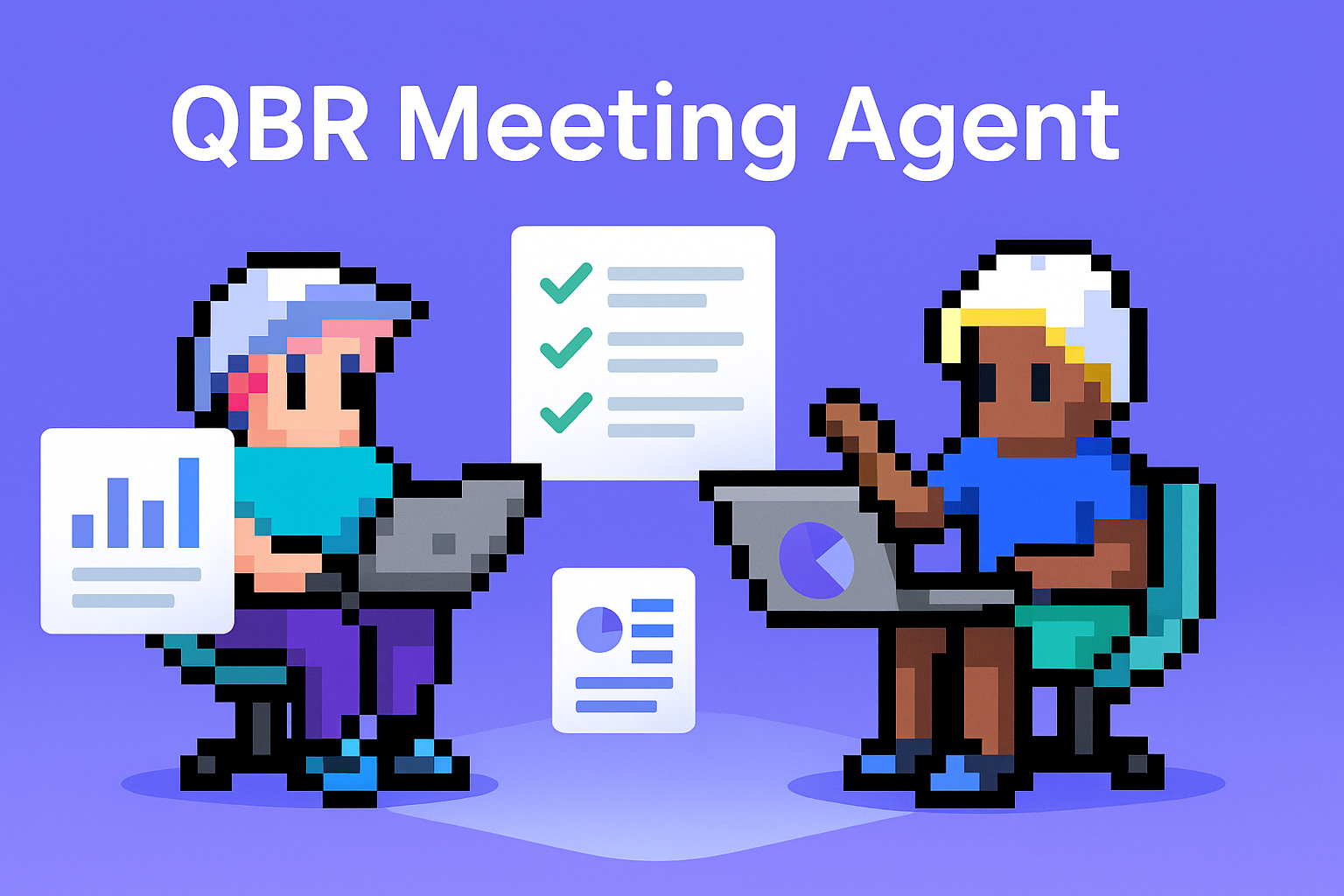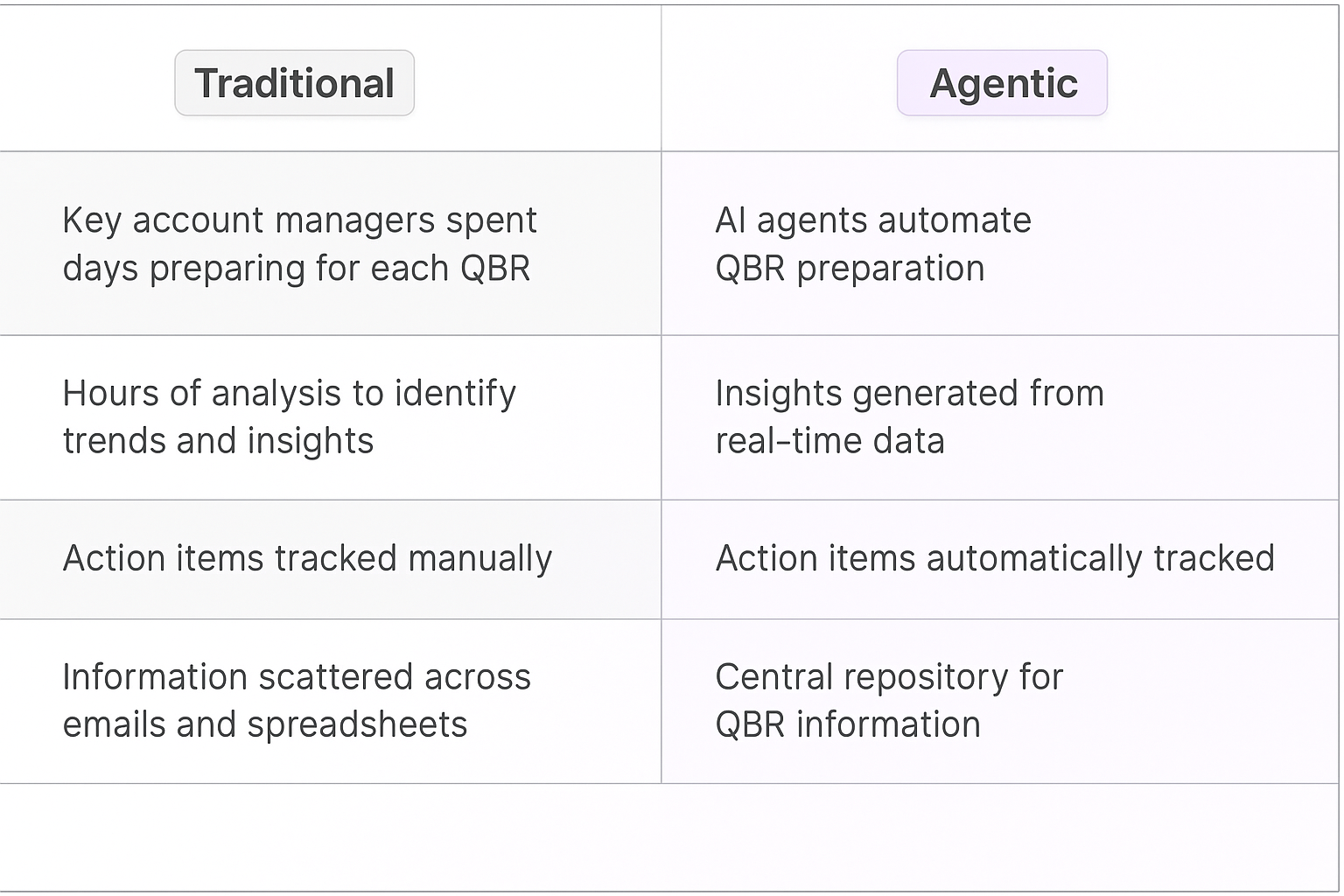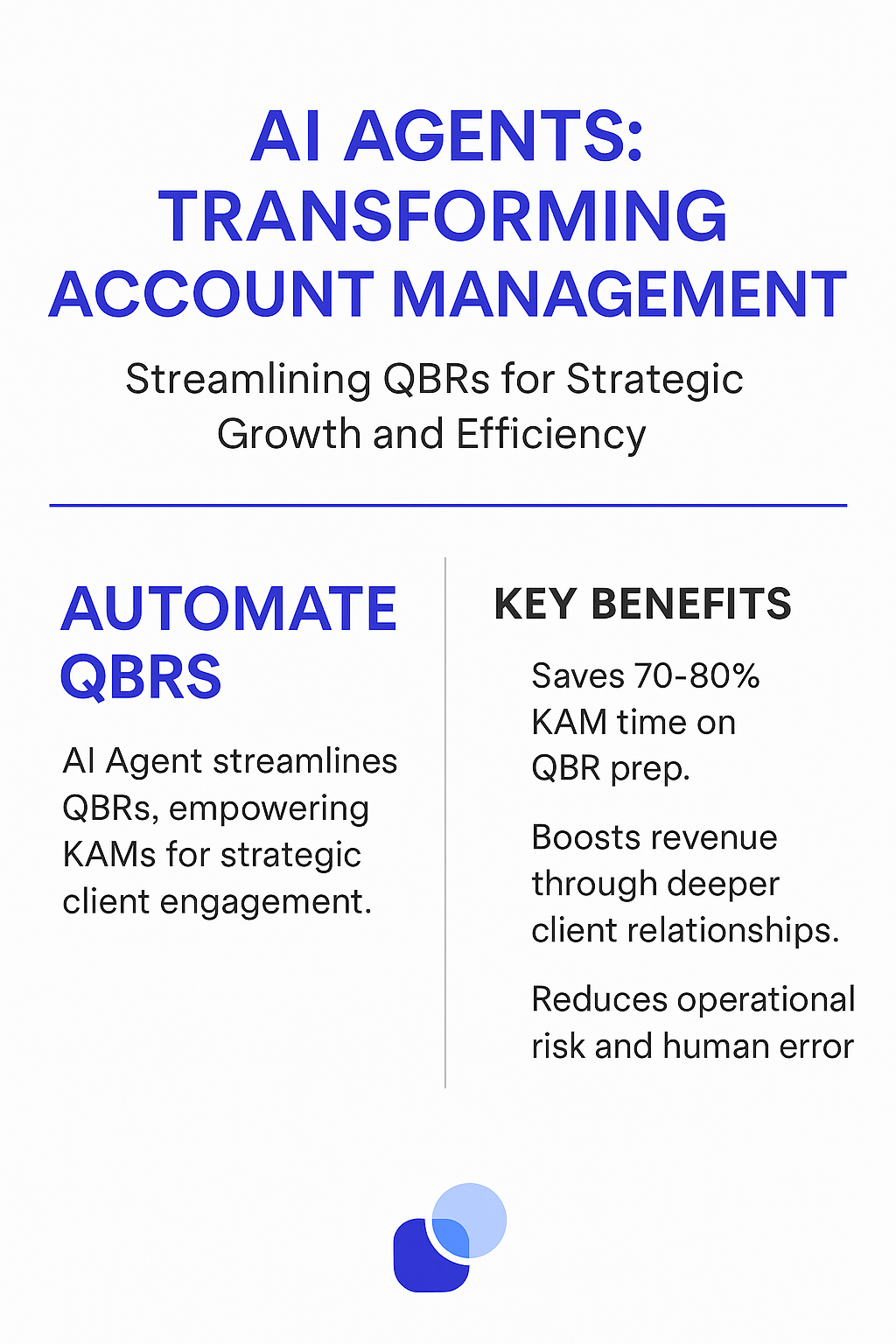
AI-powered meeting planner agents are revolutionizing how Key Account Managers conduct Quarterly Business Reviews (QBRs). These agents automate the tedious aspects of QBR preparation, execution, and follow-up, allowing managers to focus on building relationships, delivering strategic insights, and driving client success. This technology streamlines workflows, reduces administrative burden, and enhances overall productivity.
Before Meeting
Your AI agent gathers relevant performance data, identifies key trends, and generates a draft presentation deck tailored to your client's specific needs. You walk into the meeting with a compelling narrative and actionable insights.
During Meeting
As you discuss performance metrics and strategic initiatives, your AI agent captures key decisions, action items, and client feedback. This ensures that nothing gets missed and that everyone is on the same page.
After Meeting
Post-meeting, your AI agent automatically generates a summary of key takeaways, assigns action items to relevant stakeholders, and tracks progress. This helps you stay on top of follow-up activities and ensures that commitments are met.
What you’ll need
You don't need to be a developer to set up this integration. Follow this simple guide to get started:
- Meeting Notetaker Agent template
- Calendar account
- Meetings to join
- Relevance AI Account

Who this agent is for
This agent is designed for Key Account Managers, Sales Directors, Customer Success Managers, and anyone responsible for conducting Quarterly Business Reviews (QBRs) with key clients. It's ideal for individuals and teams who need to present performance data, discuss strategic initiatives, and align on future goals with their most important customers. Whether you're managing a portfolio of enterprise accounts or working with strategic partners, this agent simplifies the QBR process and ensures that you deliver maximum value to your clients.
How this agent makes QBR planning easier
Automate data gathering and analysis
Instead of manually compiling data from multiple sources, the agent automatically gathers relevant performance metrics, identifies key trends, and generates insightful reports.
Create personalized presentation decks
The agent uses AI to create customized presentation decks tailored to each client's specific needs and priorities. This saves time and ensures that your presentations are always relevant and engaging.
Track action items and follow-up activities
The agent automatically captures action items during the QBR and assigns them to relevant stakeholders. It also tracks progress and sends reminders to ensure that commitments are met.
Improve communication and collaboration
The agent facilitates better communication and collaboration by providing a central repository for all QBR-related information, including presentations, notes, and action items.
Benefits of AI Agents for Key Account Managers
What would have been used before AI Agents?
Key Account Managers traditionally relied on manual methods for preparing and conducting QBRs, such as spreadsheets, presentation software, and email threads. This process was time-consuming, prone to errors, and often resulted in inconsistent messaging. They would spend countless hours gathering data, creating presentations, and coordinating follow-up activities, taking away from their core responsibilities of building relationships and driving client success.
What are the benefits of AI Agents?
AI agents offer a streamlined and automated approach to QBR planning, freeing up Key Account Managers to focus on more strategic tasks. The most significant benefit is the time saved by automating data gathering, presentation creation, and follow-up coordination. The agent handles everything from identifying key trends to assigning action items, reducing the administrative burden on the manager.
AI agents also improve the quality and consistency of QBRs by providing data-driven insights and personalized messaging. This ensures that presentations are always relevant and engaging, and that clients receive maximum value from the meetings. Furthermore, the agent enhances communication and collaboration by providing a central repository for all QBR-related information.
By integrating with existing CRM and project management tools, the agent provides a seamless and user-friendly experience. This eliminates the need for manual data entry and ensures that all QBR activities are accurately recorded and easily accessible. Ultimately, AI agents enhance productivity, reduce stress, and allow Key Account Managers to focus on building strong client relationships and driving revenue growth.
Traditional vs Agentic meeting planning
Traditionally, Key Account Managers spent days preparing for each QBR, manually compiling data and creating presentations. Now, AI agents automate this, freeing up time for strategic thinking. Before, identifying key trends and insights required hours of analysis. With an agent, these insights are generated automatically, based on real-time data. Action items used to be tracked manually, often leading to missed deadlines. Now, they're automatically assigned and tracked, ensuring accountability. Communication was fragmented, with information scattered across emails and spreadsheets. The agent provides a central repository for all QBR-related information, improving collaboration. Finally, follow-up activities were often delayed or forgotten. The agent automates reminders and tracks progress, ensuring that commitments are met.

Tasks that can be completed by a QBR Agent
Key Account Managers juggle numerous tasks, from building relationships with clients to developing strategic plans and driving revenue growth. A QBR agent can handle many of the administrative tasks associated with planning and conducting QBRs, allowing managers to focus on their core responsibilities.
Gathering and Analyzing Performance Data
The agent automatically gathers relevant performance metrics from various sources, such as CRM systems, marketing automation platforms, and financial databases. It then analyzes the data to identify key trends and insights.
Creating Personalized Presentation Decks
The agent uses AI to create customized presentation decks tailored to each client's specific needs and priorities. This includes selecting relevant charts and graphs, writing compelling narratives, and incorporating client-specific branding.
Tracking Action Items and Follow-Up Activities
The agent automatically captures action items during the QBR and assigns them to relevant stakeholders. It also tracks progress and sends reminders to ensure that commitments are met.
Generating Meeting Summaries and Reports
The agent automatically generates meeting summaries and reports that capture key takeaways, decisions, and action items. These summaries can be shared with clients and internal stakeholders to ensure alignment and accountability.
Scheduling and Coordinating Meetings
The agent can assist with scheduling and coordinating QBRs, taking into account the availability of all participants and sending out meeting invitations and reminders.
Integrating with CRM and Project Management Tools
The agent integrates with popular CRM and project management tools, such as Salesforce, HubSpot, and Asana, to ensure that all QBR-related information is accurately recorded and easily accessible.
Providing Real-Time Insights and Recommendations
During the QBR, the agent can provide real-time insights and recommendations based on the data it has gathered and analyzed. This can help managers make more informed decisions and provide more value to their clients.

Things to Keep in Mind When Building a QBR Agent
Building an effective QBR agent requires careful planning and attention to detail. The goal is to create an agent that seamlessly integrates with your existing workflows and provides a user-friendly experience for both managers and clients.
Define Clear Objectives
Before you start building your agent, define clear objectives for what you want it to achieve. Do you want to reduce preparation time, improve the quality of presentations, enhance communication, or all of the above? Having clear objectives will help you prioritize features and measure success.
Integrate with Existing Systems
Ensure that your agent integrates seamlessly with your existing CRM, marketing automation, and project management systems. This will allow it to access the data it needs to generate insights and automate tasks.
Prioritize Data Security and Privacy
QBRs often involve sensitive client data, so it's essential to prioritize data security and privacy when building your agent. Implement robust security measures to protect client information and comply with relevant regulations.
Provide Customizable Templates and Settings
Allow users to customize the agent's templates and settings to match their specific needs and preferences. This might include customizing the layout of presentation decks, specifying which data sources to use, and setting notification preferences.
Automate Reminders and Follow-Ups
Configure the agent to send automated reminders and follow-up emails to keep participants informed and engaged. This will help ensure that action items are completed on time and that clients receive the support they need.
Test Thoroughly
Before you roll out the agent to your entire team, test it thoroughly to ensure that it is working correctly and that it meets your objectives. Gather feedback from users and make any necessary adjustments.
Continuously Improve
Once your agent is live, continue to monitor its performance and gather feedback from users. Use this information to identify areas for improvement and make ongoing enhancements.
The Future of AI Agents in QBR Planning
The future of AI agents in QBR planning is bright, with advancements in natural language processing, machine learning, and artificial intelligence promising to further streamline and enhance the QBR process. Future agents will be able to understand complex client needs, anticipate potential challenges, and proactively suggest solutions.
AI agents will also become more personalized, learning individual client preferences and tailoring their recommendations accordingly. They will be able to identify preferred communication styles, preferred meeting formats, and even preferred topics of discussion, creating a more seamless and engaging experience.
Furthermore, AI agents will play a larger role in facilitating collaboration and communication during QBRs. They will be able to transcribe meeting minutes, track action items, and even provide real-time translation services, making QBRs more productive and inclusive.
AI agents will also integrate with other business applications, such as sales forecasting tools and customer sentiment analysis platforms, providing a holistic view of client relationships and enabling better decision-making.
Ultimately, the future of AI agents in QBR planning is about creating intelligent systems that not only automate the QBR process but also enhance client relationships, improve communication, and drive better business outcomes.









